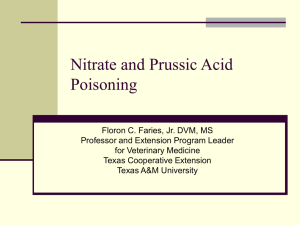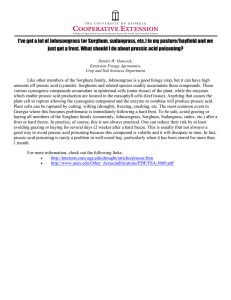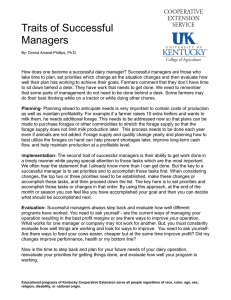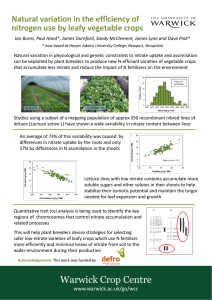Nitrates and Prussic Acid in Forages Sampling, Testing and Management Strategies
advertisement
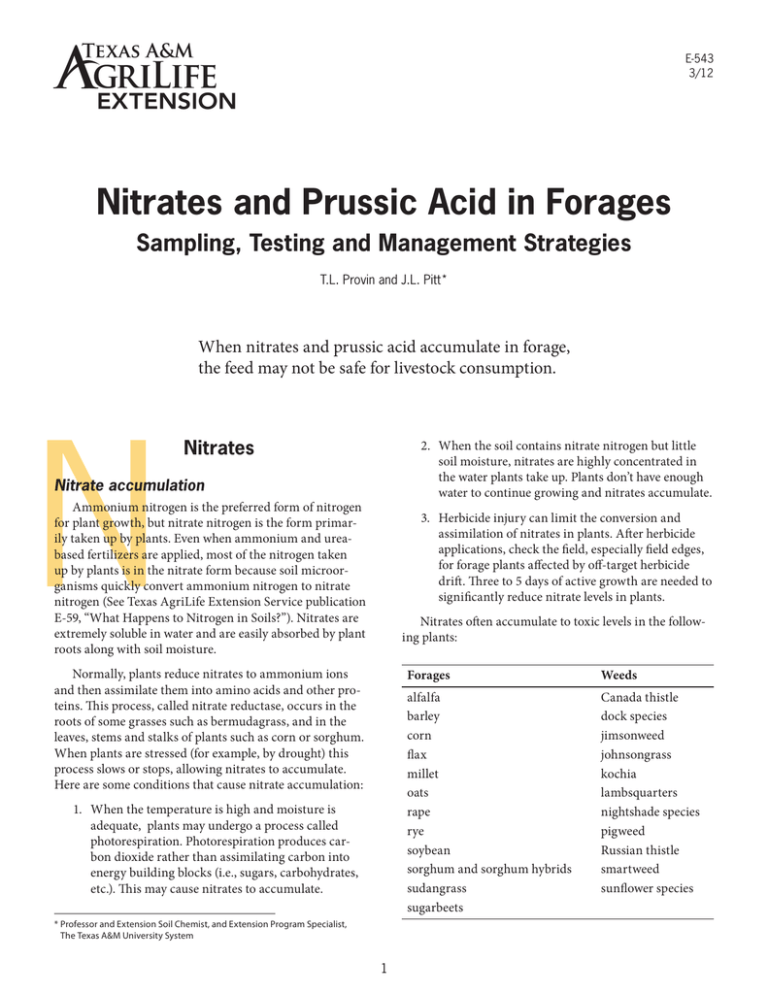
E-543 3/12 Nitrates and Prussic Acid in Forages Sampling, Testing and Management Strategies T.L. Provin and J.L. Pitt* When nitrates and prussic acid accumulate in forage, the feed may not be safe for livestock consumption. N Nitrates 2. When the soil contains nitrate nitrogen but little soil moisture, nitrates are highly concentrated in the water plants take up. Plants don’t have enough water to continue growing and nitrates accumulate. Nitrate accumulation Ammonium nitrogen is the preferred form of nitrogen for plant growth, but nitrate nitrogen is the form primarily taken up by plants. Even when ammonium and ureabased fertilizers are applied, most of the nitrogen taken up by plants is in the nitrate form because soil microorganisms quickly convert ammonium nitrogen to nitrate nitrogen (See Texas AgriLife Extension Service publication E-59, “What Happens to Nitrogen in Soils?”). Nitrates are extremely soluble in water and are easily absorbed by plant roots along with soil moisture. 3. Herbicide injury can limit the conversion and assimilation of nitrates in plants. After herbicide applications, check the field, especially field edges, for forage plants affected by off-target herbicide drift. Three to 5 days of active growth are needed to significantly reduce nitrate levels in plants. Nitrates often accumulate to toxic levels in the following plants: Normally, plants reduce nitrates to ammonium ions and then assimilate them into amino acids and other proteins. This process, called nitrate reductase, occurs in the roots of some grasses such as bermudagrass, and in the leaves, stems and stalks of plants such as corn or sorghum. When plants are stressed (for example, by drought) this process slows or stops, allowing nitrates to accumulate. Here are some conditions that cause nitrate accumulation: 1. When the temperature is high and moisture is adequate, plants may undergo a process called photorespiration. Photorespiration produces carbon dioxide rather than assimilating carbon into energy building blocks (i.e., sugars, carbohydrates, etc.). This may cause nitrates to accumulate. *Professor and Extension Soil Chemist, and Extension Program Specialist, The Texas A&M University System 1 Forages Weeds alfalfa barley corn flax millet oats rape rye soybean sorghum and sorghum hybrids sudangrass sugarbeets Canada thistle dock species jimsonweed johnsongrass kochia lambsquarters nightshade species pigweed Russian thistle smartweed sunflower species When rotational grazing or single-field grazing systems are used, a more conservative sampling approach is warranted because livestock will consume not just the leaves and upper plant parts but also the stems (which contain more nitrate). Take the lower one-third to one-half of traditional grasses, small grains and legumes for nitrate analysis, and the lower one-third of corn stalks, sorghum and sorghum-sudangrass stalks. While these plants are the ones most likely to accumulate nitrates, nitrates are present to some degree in all for-ages, including bermudagrasses. Nitrates are nonvolatile and remain in nonensiled plants after cutting, curing and baling. Nitrates are soluble in plant tissues and will leach from the plant during sustained rainfall. However, weathering significantly reduces the nutritional value of hay bales so it is not a good way to manage nitrates. Furthermore, the movement of leached nitrates within a weathered bale may limit the use of the forage. To sample standing forage, create a composite sample from plant parts taken from at least 10 to 15 areas with the same fertility and moisture conditions. Do not mix plants from “good” and “bad” parts of the field. Create different composite samples for these areas. Ship samples to the laboratory in clean paper sacks. Do not use plastic bags because the high moisture content will cause the samples to mold, which interferes with the nitrate analysis. Research at the Texas Veterinary Medical Diagnostic Laboratory (TVMDL) at Texas A&M University has found that it is safe to feed forage containing 1 percent nitrate (on a dry-matter basis) to healthy ruminants. Forage with a higher percentage of nitrate could be fed if it is ground and mixed with nitrate-free forage to reduce overall nitrate levels to less than 1 percent (dry-matter basis). Forage containing 0.5 to 1 percent nitrate should not be fed to weakened cattle unless your veterinarian has approved it. The 1 percent nitrate level set by the TVMDL is significantly higher than levels suggested by other southern universities. This level assumes that cattle are healthy, well conditioned, and being fed a high-energy diet. To sample forage in bales, take representative core samples with a bale probe. This is the only sampling method that will adequately evaluate the average nitrate levels in the bale, but this method can not be used for sampling coarse-stemmed forage such as corn, sorghum, sorghum-sudangrass or similar plants unless the bale will be ground before it is fed. To sample a bale of coarsestemmed forage, split the bale open and collect the lower stems of individual plants to ensure that the highest possible nitrate level is revealed by the analysis. This will guard against timid animals consuming too much nitrate (in the lower stems) because the leaves and more palatable upper stems were eaten by the first animals at the bale. In healthy cattle, the nitrate consumed in normal forages is converted into protein in the rumen: nitrate→nitrite→ammonia→amino acids→proteins Symptoms of nitrate poisoning If forage contains too much nitrate the animals cannot complete the conversion and nitrite levels build up. Nitrite is adsorbed directly into the bloodstream through the rumen wall, where it combines with hemoglobin to form methhemoglobin. Hemoglobin carries oxygen in the blood, but methhemoglobin does not. The formation of methhemoglobin can cause an animal to die from asphyxiation, or lack of oxygen. The animal’s blood turns brown instead of the normal bright red. Monogastrics (i.e., horses, mules, swine, etc.) are less sensitive to nitrate toxicity than ruminants. An animal’s conditioning affects its ability to assimilate or tolerate nitrates, so consult your veterinarian before feeding forage that contains nitrates. Nitrate testing For forages grown under the conditions described above, proper management practices include testing for nitrates. Testing can be done both in the field and in the laboratory. Field methods include qualitative spot color methods and some quantitative methods that use colorimeters and nitrate electrodes. However, field methods should be considered only as qualitative tools because it is difficult to obtain uniform samples and the tests are not precise enough to use the results for mixing feeds. One quick test is the diphenylamine spot test. The Texas AgriLife Extension Soil, Water and Forage Testing Laboratory has long manufactured these quick-test kits for plant nitrate analysis, but because the kits contain sulfuric acid, shipping them has become difficult. The laboratory is investigating alternative quick-test methods. The diphenyl-amine test is comprised of diphenylamine salt (0.1 grams)dissolved in sulfuric acid (30 ml-36N). A single drop of this acid reagent is placed on a freshly split plant stem. If a dark blue color develops immediately (in the first 5 seconds), nitrate is present. If there is no immediate change in color there is no nitrate; however, a dark color(brown/black) will eventually develop if the reagent Sampling for nitrates The highest nitrate accumulation is in the lower stem,and the least is in the leaves. The forage species and the grazing method determine how plant samples should betaken for forage analysis. If limit-grazing is practiced, and forage consists of traditional grasses, small grains or legumes, remove only the upper one-third to one-half of the plant for a sample. These are the plant parts that animals will consume. When limit-grazing corn, sorghum, sorghum-sudangrass and similar forages, sample only the plant leaves. 2 All the management systems described here should be used in tandem with proper sampling and analysis. remains on the plant tissue for an extended time. The dark color is caused by acid caramelizing the plant sugars and carbohydrates. The pictures below illustrate results of the nitrate spot test. Managing standing forages: 1. First, carefully determine the nitrate levels in various plant parts. Allow animals to graze the upper one-third to one-half of the grass, legume or leaves of coarse-stemmed forages if the nitrate level in these plant parts is safe. Monitor grazing closely and remove livestock when the safe portion of the forage is consumed. 2. Monitor nitrate levels in the lower one-third to onehalf of the plant or coarse stems if livestock are to be released into a field with questionable or potentially toxic nitrate levels. Generally, forage nitrate levels drop significantly 3 to 5 days after sufficient rainfall. 3. A third management practice is to cut the forage for hay, field cure and bale it. This will not lower the nitrate levels, but the bales can be ground and mixed with nitrate-free forages to retain a higher overall protein and energy value. 4. The forage could be harvested and ensiled. During the ensiling process nitrates are converted to volatile nitrous oxides, also called “silo gases.” These gases are highly toxic and workers should be extremely careful when entering silo pits and bunkers where nitrate-tainted forages have been ensiled. A common safety practice is to remove tarps from a portion of the silo a day or two before removing silage from that part of the pit. The diphenylamine field test indicates only the presence or absence of nitrate. It does not determine the actual nitrate concentration and, as with any field test method, it should be used only as a screening tool. Any positive result from the spot test should be followed up with a laboratory analysis for quantification. A field test can help you quickly estimate what stem height is safe for grazing. Most field test methods work only on moist plants with stems thick enough to split and apply the test reagent. Dried plants, hay, silage, fine-stemmed grasses and similar material should be tested in a laboratory. Managing baled hay: 1. There are fewer options for managing baled forages that contain nitrates. The safest method is to grind the bales and thoroughly mix them with hay that is free of nitrate. There should be enough good forage in the mix to reduce the nitrate level to less than 1 percent. It is best to mix similar forage types so that the feed has a uniform particle size distribution. The optimum size is dictated by stem size; in general, the smaller the better. A handful of ground and mixed feed should contain portions of all plant parts from all forages used in the mix. The uniform size will help limit selective feeding by livestock. This grinding and mixing method should not be used for forages containing more than 2.5 percent nitrate. Interpreting laboratory reports Nitrate content may be expressed as actual nitrate (% NO3) or nitrate-N (% NO3-N) values. The Texas AgriLife Extension Soil, Water and Forage Testing Laboratory reports nitrate in forage as actual nitrate. The industry standard is to report forage nitrates as percent nitrate, which differs from plant nitrate analysis. Plant nitrates are expressed as ppm nitrate-N. To convert nitrate-N levels to actual nitrate, multiply by 4.42. Some labs may report in parts per million (ppm). To convert ppm to per-cent, divide by 10,000. Understand the reporting method of the laboratory you use to prevent confusion that could cause you to feed a toxic nitrate level to livestock. 2. If nitrate levels are higher than 2.5 percent or there is no way to grind and mix the forage, do not use the baled forage for livestock feed or bedding. Nitrate management The best way to manage forages that contain nitrates is determined by the forage type and the harvest method. 3 P Prussic Acid • Plants are injured by herbicides, frost, hail or other events. Prussic acid in forages can pose a significant risk to certain grazing and barnyard livestock. Plants that accumulate prussic acid include: Forage or plant Prussic acid potential pearl and foxtail millet sudangrass and sudangrass hybrids sorghum-sudangrass hybrids forage sorghum shattercane johnsongrass grain sorghum sorghum almum arrowgrass velvetgrass white clover birdsfoot trefoil chokecherry* pincherry* wild black cherry* apricot* peach* apple* elderberry* very low low or moderate moderate to high moderate to high high high to very high high to very high high to very high low low low low low low low low low low low Symptoms of prussic acid poisoning The plants listed above produce cyanogenic glucosides (prussic acid) as they grow. Glucosides are sugar compounds that break down in the rumen, freeing the cyanide from the sugar and forming hydrocyanic acid. Hydrocyanic acid (HCN) is commonly known as cyanide. The HCN combines with hemoglobin to form cyanoglobin, which does not carry oxygen. Livestock poisoned by cyanide have respiratory stress similar to that caused by nitrate poisoning. A blood test can quickly distinguish between nitrate and prussic acid poisoning. If prussic acid is the toxic agent the blood will be cherry red, unlike the chocolate brown blood seen in nitrate poisoning. Horses, hogs and other nonruminant animals are less affected by prussic acid because their stomachs convert the prussic acid to less toxic formic acid and ammonium chloride. Prussic acid poisoning can be treated effectively if the treatment is administered immediately after the first poisoning symptoms appear. Two common treatments are intravenous injection (125 to 250 ml) of 1.2% sodium nitrate or 7.4% sodium thiosulfate. Before administering the sodium nitrate treatment, have a veterinarian ensure that the symptoms are caused by prussic acid rather than nitrate. Sampling for prussic acid Prussic acid accumulates mainly in leaves, with highest concentrations in new growth. Concentrations in leaves are many times higher than in stems. Because livestock usually eat leaves before stems, samples taken for prussic acid analysis should be largely comprised of leaves. This is especially true when sampling fields where cattle will be allowed to graze. If grazing is limited, cattle probably will not consume stems. * Prussic acid may be found in the leaves and seeds of these tree species but it is not likely that livestock will consume much of these plants. Do avoid housing livestock near these trees, especially if traditional forages are not available. Under normal conditions, when these plants are actively growing and healthy, they contain low levels of prussic acid because the compound breaks down over time, thus eliminating toxic accumulations. Unlike nitrate, prussic acid may be present for a while and then dissipate from plants properly cured for hay. Unlike nitrates, prussic acid may volatilize from cut/ harvested forages. The amount of volatilization in samples can be reduced by placing the samples in resealable plastic bags or pint glass jars before sending them to a laboratory. When filling the bag or jar, allow 25 to 50 percent head space. Prussic acid accumulation can happen when: To sample standing forages, selectively remove the newest upper leaves from 10 to 12 plants in different areas of the field. Sample in locations most likely to have prussic acid problems (review the common causes). Place leaves in a sealable container, place the container on ice (but do not freeze), and ship immediately to the testing laboratory. • There are poor growing conditions that prevent stems from developing properly. • Recent hay harvest or grazing causes slow and stunted growth of new plant tissue. To sample baled forages, use a bale probe. Samples simply grabbed from the outsides of bales may not give accurate results because of volatilization. Place a single bale core in a sealed pint jar. More detailed instructions on • Nitrogen fertilizers are over-used or there are other soil fertility or nutrient imbalances. • Plants develop new growth after a prolonged drought. 4 sampling and shipping samples for prussic acid analysis can be obtained from the TVDML. Forage analyses at Texas A&M University Two Texas A&M University laboratories analyze forage samples. The Texas AgriLife Extension Soil, Water,and Forage Testing Laboratory (SWFTL) measures plant nitrates, protein, ADF and minerals. Analyzing just for nitrate concentrations does not give useful information about the nutritive value of the forage and the need for energy or protein supplementation. The laboratory does not do prussic acid analysis. The SWFTL Web site is http://soiltesting.tamu.edu. The phone number is (979) 845-4816. There is also the Texas Veterinary Medical Diagnostic Laboratory (TVMDL), which specializes in toxicological analysis of feeds, forages and animals. The TVMDL can do both nitrate and prussic acid testing. The TVMDL can be reached at (979) 845-3414. A testing laboratory can evaluate the prussic acid concentration either qualitatively or quantitatively. Some references suggest that 250 ppm HCN is a safe level. However, the extreme variability in prussic acid sampling and shipping methods and rapid field changes limit the value of a quantitative result. A simple qualitative analysis to show whether or not prussic acid is present will generally suffice. If a forage does contain prussic acid, livestock should not be allowed to consume it until the level declines to the point that it is no longer detectable. Prussic acid management Forage type and harvest method determine the best management techniques. 1. Standing forages that test positive for prussic acid and will be grazed should be sampled every 3 to 4 days. With frequent sampling, forage can be grazed as soon as it is safe and before its nutritive value decreases more than necessary. Additional Sources of Information “What Happens to Nitrogen in Soils?” Texas AgriLife Extension, E-59. “Sampling Hay and Pastures for Forage Analysis,” Texas AgriLife Extension, E-148. 2. Standing forages can be green chopped and ensiled. Prussic acid is enzymatically converted to free cyanide, which escapes when silage is removed. Another benefit of green chop/silage systems is that the effect of prussic acid is diluted when livestock are not free to select only leaves. “Nitrate and Prussic Acid Poisoning,” Texas AgriLife Extension, L-5231. “Prussic Acid Poisoning,” Cooperative Extension, University of Nebraska-Lincoln, G86-775-A. “Prussic Acid Poisoning,” Colorado State University Cooperative Extension, 1.612. 3. Standing forages also can be cut, field cured and baled. As with all baled forages, proper sampling with a bale probe is required. Bales should be sampled repeatedly until prussic acid is no longer detected. Bales can be made even safer by grinding them to combine leaves and stems. “Preventing Prussic Acid Poisoning of Livestock,” Oregon State University Extension, Circular 950. “Prussic Acid Poisoning in Livestock,” Oklahoma Cooperative Extension Service, F-2904. “Prussic Acid Poisoning in Livestock,” New Mexico State University, Guide B-808. 5
